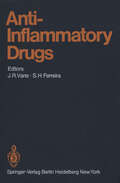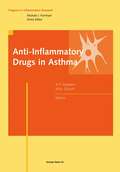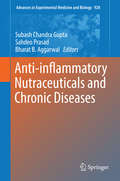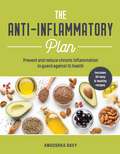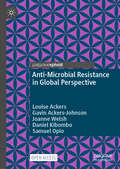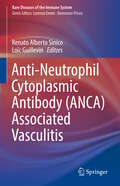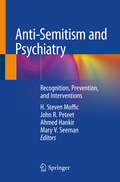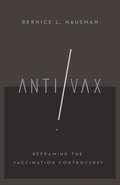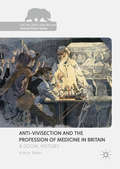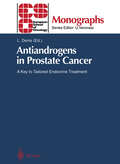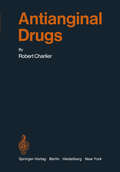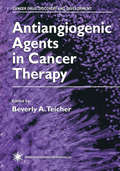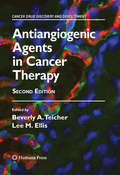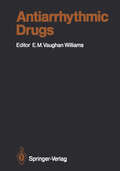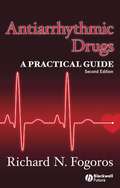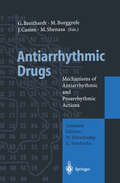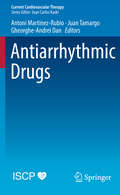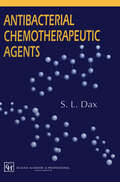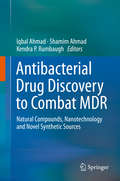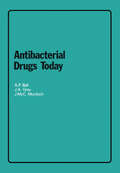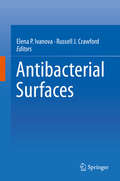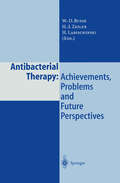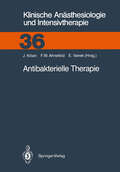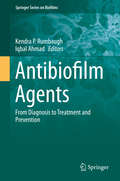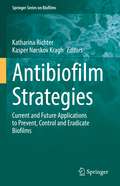- Table View
- List View
Anti-Inflammatory Drugs (Handbook of Experimental Pharmacology #50 / 2)
by C.G. van ArmanWith contributions by numerous experts
Anti-Inflammatory Drugs in Asthma (Progress in Inflammation Research)
by Martin K. Church Anthony P. SampsonFor some years, international guidelines on the management of asthma have stressed the importance of early intervention with anti-inflammatory drugs to prevent acute asthma exacerbations and to avert chronic inflammatory damage to the airway. Introduced by a broad survey of the targets for anti-inflammatory drugs, this book proceeds to bring together the most recent research into the mechanisms and clinical benefits of presently available anti-inflammatory treatments including corticosteroids, cromones, and theophylline. For the first time, these drugs are discussed alongside the newly introduced leukotriene modifier drugs, and in the context of frontline research into anti-inflammatory drugs of the future. Leading authorities in their fields evaluate the prospects of novel anti-IgE agents and cytokine antagonists, and examine recent developments in immunosuppressant compounds, protease inhibitors, and selective phosphodiesterase inhibitors. This book is an up-to-date and authoritative survey which will be invaluable to university and pharmaceutical company researchers working on anti-asthma and anti-allergy drugs and to respiratory physicians keeping abreast of developments in their specialty.
Anti-inflammatory Nutraceuticals and Chronic Diseases (Advances in Experimental Medicine and Biology #928)
by Subash Chandra Gupta Sahdeo Prasad Bharat B. AggarwalThis comprehensive volume focuses on anti-inflammatory nutraceuticals and their role in various chronic diseases. Food and Drug Administration (FDA) approved drugs such as steroids, non-steroidal anti-inflammatory drugs (NSAIDS), statins and metformin have been shown to modulate inflammatory pathways, but their long-term intake has been associated with numerous side effects. This means that there is enormous potential for dietary agents that can modulate inflammatory pathways in humans. Leading experts describe the latest research on the role of anti-inflammatory nutraceuticals in preventing and treating chronic diseases.
The Anti-inflammatory Plan: Prevent and Reduce Chronic Inflammation to Guard Against Ill Health
by Anoushka DavyInflammation is a normal and essential part of the body's defence system. It signals that damage is present and that the rest of the immune system needs to kick into action. However, when it becomes chronic, steps need to be taken to heal inflammation-related problems.Divided into four parts, The Anti-inflammation Plan guides the reader through the science behind inflammation and how it affects the body; ways of reducing it by getting enough sleep and reducing stress; the essential ingredients and nutrients needed such as green leafy vegetables, tomatoes and turmeric. The final part of the book offers 30 easy and delicious recipes making this book a comprehensive plan for reducing inflammation in the body.
Anti-Microbial Resistance in Global Perspective
by Louise Ackers Gavin Ackers-Johnson Joanne Welsh Daniel Kibombo Samuel Opio‘The Maternal Sepsis Intervention has had a profound impact on maternal mortality and antibiotic use whilst also reducing hospital costs. The Ministry of Health is keen to explore opportunities to extending the lessons learnt and integrate them in national policy-making.' -Dr. Richard Mugahi, Ministry of Health, Uganda. This open access book provides an accessible introduction to the mechanics of international development and global health text for policy-makers and students across a wide range of disciplines. Antimicrobial resistance is a major threat to the well-being of patients and health systems the world over. In fragile health systems so challenged, on a day-today basis, by the overwhelming burden of both infectious and non-communicable disease, it is easy to overlook the impacts of AMR. The Maternal Sepsis Intervention, focusing on a primary cause of maternal death in Uganda, demonstrates the systemic nature of AMR and the gains that can be made through improved Infection Prevention Control and direct engagement of laboratory testing in antibiotic prescribing.
Anti-Neutrophil Cytoplasmic Antibody (Rare Diseases of the Immune System)
by Renato Alberto Sinico Loïc GuillevinThis volume, written by well-known experts in the field, covers all aspects of Anti-Neutrophil Cytoplasmic Antibody (ANCA) Associated Vasculitis (AAV). The expression refers to a group of diseases, characterized by destruction and inflammation of small vessels. The clinical signs vary and affect several organs, such as the kidney, lung, skin, nervous system and others. The opening chapters give some historical hints, explain the genetic basis of the disease and provide insights into the pathogenesis derived from recent experimental studies and guides the reader through classification and nomenclature. A large part of the book is then devoted to a detailed description of the specific related diseases and their clinical presentations, the disease course, and potential complications. The advice regarding treatment is based on the best currently available evidence in this constantly evolving area. The book is part of Springer’s series Rare Diseases of the Immune System, which presents recently acquired knowledge on pathogenesis, diagnosis, and therapy with the aim of promoting a more holistic approach to these conditions. AAVs are systemic autoimmune diseases of unknown cause that affect small (to medium) sized blood vessels. They include granulomatosis with polyangiitis (formerly Wegener's granulomatosis), microscopic polyangiitis, and eosinophilic granulomatosis with polyangiitis (formerly Churg–Strauss syndrome). This volume will be an invaluable source of up-to-date information for all practitioners involved in the care of patients with these diseases.
Anti-Semitism and Psychiatry: Recognition, Prevention, and Interventions
by H. Steven Moffic John R. Peteet Ahmed Hankir Mary V. SeemanFollowing World War II and the exposure of the concentration camps, psychiatry turned its attention to a vast range of cultural concerns with results that seemed to indicate a decline of stigma over time. However, it is now clear that whatever drives prejudices, especially in the case of anti-Semitism, was just dormant and perhaps not fully understood. Hate crimes and anti-Semitism broad recently re-emerged in Europe, and the United States followed shortly thereafter. The US Federal Bureau of investigation reports that New York City, which is still considered the most Jewish-friendly region in the US, experienced a 22% spike in anti-Semitic hate crimes in 2018 alone, with more extremes in other regions of the country. Neo-Nazi groups have grown stronger in the United States and abroad, often resulting in organized acts of violence. The recent Tree of Life synagogue shooting in Pittsburgh, PA demonstrated that these acts are not limited to one-on-one interactions, but sometimes as prolific, large-scale act. The medical community is not immune from biases either. The Cleveland Clinic recently fired a young doctor after she publicly declared her wishes to inject Jewish patients with lethal substances, which is only one of many hateful comments she made on social media over the course of several years. Psychiatrists in particular grapple with this as they try to serve patients of both Jewish and non-Jewish descent who struggle to process these acts of hate. Despite all of this, there is no training and no resource to guide medical professionals through these challenges. The editors of the recent Springer book, Islamophobia and Psychiatry, recognize this gap in the literature and seek to develop another high-quality text to meet this need. Written by expert clinicians in global regions where these incidents are most prevalent, the book seeks to be neither political nor opinion-based; instead, the text takes an innovative cross-cultural psychiatric interaction, similar to what was done with Springer’s new Islamophobia book. Coverage will range from foci on the social psychiatric aspects of anti-Semitism to how it may in turn infuse clinical encounters between patients and clinicians. Written by experts in this area, the insight and expertise of psychiatrists from a variety of cultural and religious backgrounds will focus on what psychiatrists need to know to combat the negative mental health impact that increasingly rise out of this particular phenomenon. Such a multi-cultural psychiatric approach has never been taken before for this topic. This discourse is the foundation for the primary goal of this book: to develop the tools needed to improve clinical outcomes for patients. Hence, this book aims to present an updated, comprehensive bio-psychosocial perspective on anti-Semitism at the interface of clinical psychiatry.
Anti/Vax: Reframing the Vaccination Controversy (The Culture and Politics of Health Care Work)
by Bernice L. HausmanAntivaxxers are crazy. That is the perception we all gain from the media, the internet, celebrities, and beyond, writes Bernice Hausman in Anti/Vax, but we need to open our eyes and ears so that we can all have a better conversation about vaccine skepticism and its implications.Hausman argues that the heated debate about vaccinations and whether to get them or not is most often fueled by accusations and vilifications rather than careful attention to the real concerns of many Americans. She wants to set the record straight about vaccine skepticism and show how the issues and ideas that motivate it—like suspicion of pharmaceutical companies or the belief that some illness is necessary to good health—are commonplace in our society.Through Anti/Vax, Hausman wants to engage public health officials, the media, and each of us in a public dialogue about the relation of individual bodily autonomy to the state's responsibility to safeguard citizens' health. We need to know more about the position of each side in this important stand-off so that public decisions are made through understanding rather than stereotyped perceptions of scientifically illiterate antivaxxers or faceless bureaucrats. Hausman reveals that vaccine skepticism is, in part, a critique of medicalization and a warning about the dangers of modern medicine rather than a glib and gullible reaction to scaremongering and misunderstanding.
Anti-Vivisection and the Profession of Medicine in Britain: A Social History (The Palgrave Macmillan Animal Ethics Series)
by A.W.H. BatesThis book is open access under a CC BY 4.0 license.This book explores the social history of the anti-vivisection movement in Britain from its nineteenth-century beginnings until the 1960s. It discusses the ethical principles that inspired the movement and the socio-political background that explains its rise and fall. Opposition to vivisection began when medical practitioners complained it was contrary to the compassionate ethos of their profession. Christian anti-cruelty organizations took up the cause out of concern that callousness among the professional classes would have a demoralizing effect on the rest of society. As the nineteenth century drew to a close, the influence of transcendentalism, Eastern religions and the spiritual revival led new age social reformers to champion a more holistic approach to science, and dismiss reliance on vivisection as a materialistic oversimplification. In response, scientists claimed it was necessary to remain objective and unemotional in order to perform the experiments necessary for medical progress.
Antiandrogens in Prostate Cancer: A Key to Tailored Endocrine Treatment (ESO Monographs)
by Louis DenisThe European School of Oncology came into existence to respond to a need for information, education and training in the field of the diagnosis and treatment of cancer. There are two main reasons :o/hy such an initiative was considered necessary. Firstly, the teaching of oncology requires a rigorously multidisciplinary approach which is difficult for the Universities to put into practice since their system is mainly disciplinary orientated. Secondly, the rate of technological development that impinges on the diagnosis and treatment of cancer has been so rapid that it is not an easy task for medical faculties to adapt their curricula flexibly. With its residential courses for organ pathologies and the seminars on new techniques (laser, monoclonal antibodies, imaging techniques etc.) or on the principal therapeutic controversies (conservative or mutilating surgery, primary or adjuvant chemotherapy, radiotherapy alone or integrated), it is the ambition of the European School of Oncology to fill a cultural and scientific gap and, thereby, create a bridge between the University and Industry and between these two and daily medical practice. One of the more recent initiatives of ESO has been the institution of permanent study groups, also called task forces, where a limited number of leading experts are invited to meet once a year with the aim of defining the state of the art and possibly reaching a consensus on future developments in specific fields of oncology.
Antianginal Drugs: Pathophysiological, Haemodynamic, Methodological, Pharmacological, Biochemical and Clinical Basis for Their Use in Human Therapeutics (Handbook of Experimental Pharmacology #31)
by Robert CharlierUse in
Antiangiogenic Agents in Cancer Therapy (Cancer Drug Discovery and Development)
by Beverly A. TeicherBeverly Teicher and a panel of distinguished investigators survey the state-of-the-art of antiangiogenesis research from the lab bench to clinical trials. Timely and authoritative, the contributors summarize our current understanding of tumor growth and its dependence on vascular development, as well as the present status of antiangiogenic agents in preclinical and clinical development. In addition, the book also examines what is known about the mechanisms by which these therapeutic agents interfere with tumor vasculature and grapples with the problem of establishing criteria by which to assess their clinical efficacy. Antiangiogenic Agents in Cancer Therapy offers a unique cutting-edge compendium of antiangiogenic research, taking stock of what has been accomplished , where the experimental therapeutics of antiangiogenic agents is going, and the continuing evolution of their role in cancer treatment and novel drug development.
Antiangiogenic Agents in Cancer Therapy (Cancer Drug Discovery and Development)
by Beverly A. Teicher Lee M. EllisThis volume represents a compendium of scientific findings and approaches to the study of angiogenesis in cancer. The second edition of Antiangiogenic Agents in Cancer Therapy is intended to give a current perspective on the state-of-the-art of angiogenensis and therapy directed at this process. Antiangiogenesis is a dynamic and evolving field in oncology. New therapeutic targets continue to emerge followed by the rapid development of new therapeutic agents to be investigated in clinical trials. Optimizing the therapeutic potential of antiangiogenic agents in combination with the other therapies in the armamentarium to fight cancer will be an on-going challenge.
Antiarrhythmic Drugs (Handbook of Experimental Pharmacology #89)
by T. J. CampbellThe development of a new antiarrhythmic drug involves many people with disparate skills. The organic chemist who makes it is guided not only by the structure-action relations of previous compounds, but by anticipation of a requirement for a particular type of action. In fact several of the best-known antiarrhythmics, including lidocaine, mexiletine, amiodarone and verapamil, were originally synthesized for other purposes. Physicians have to determine whether the new drug works, and pharma cologists how it works. For some years I have believed that there was room for a work which could be understood by all these groups and which could enlighten each about the point of view of the others. Thus when I was invited by Springer-Verlag to prepare a volume in their series Handbook of Experimental Pharmacology, I already had a firm conception of what its form should be. In any multi-author work there are two objectives which cannot always readily be reconciled. The first is to select topics which would relate to each other in a coherent manner. to give a logical and orderly shape to the volume as a whole. The second is to offer authors the greatest possible freedom to express themselves as they wish. When the general design was complete, prospective contributors were invited to write specific chapters, being provided with a complete list of their coauthors and chosen topics, so that they could avoid overlap.
Antiarrhythmic Drugs: A Practical Guide
by Richard N. Fogoros MDIf you prescribe for patients with arrhythmias, you will want to keep this valuable paperback close at hand. The Second Edition of this valuable reference responds to changes in the available medications as well as in the way they are currently used. The book reviews everything you need to understand and prescribe today’s antiarrhythmic drugs: mechanisms of cardiac arrhythmias and how antiarrhythmic drugs alter those arrhythmias, including common adverse effects which factors to consider in using these drugs for treatment of supraventricular tachyarrhythmias, ventricular arrhythmias, and arrhythmias in pregnancy a detailed review of atrial fibrillation to help you make decisions for patient management in this complicated area Dr. Fogoros considers all the most recent drugs, plus promising drugs under investigation, to give you a full picture of therapeutic options. With Antiarrhythmic Drugs: A Practical Guide, Second Edition, you will have dependable information on how each drug works and when each one is indicated so you can give your patients the best possible treatment.
Antiarrhythmic Drugs: Mechanisms of Antiarrhythmic and Proarrhythmic Actions
by W. Haverkamp G. HindricksThe past 10 years have seen a remarkable change in the approach to cardiac arrhythmias, from a position of confidence and a feeling of well-being about pharmacological treatment to a situation in which there is now marked uncertainty and general apprehension about the role of antiarrhythmic drugs. Until relatively recently the prevailing concept in antiarrhythmic therapy was that arrhythmias could be controlled by drugs which slowed conduction or suppressed automaticity, goals well served by the sodium channel-blocking drugs and glycosides. Drug re search was based largely on the development of agents mimicking those already available, but with greater efficacy, fewer side effects or a more favourable phar macokinetic profile. The CAST trial stands out as a landmark in the evolution of arrhytmia manage ment; rarely has a single trial had such a profound impact not only on clinical prac tice, but also on the whole approach of those involved in the research, development and regulation of antiarrhythmic drugs. The results of the CAST trial, designed to redress the shortcomings of earlier trials which had failed to demonstrate the anticipated improvement in mortality post-myocardial infarction with the use of class I agents, are well known. The CAST and CAST II showed an increase in mor tality associated with the active agent (encainide, flecainide or morizicine) com pared to placebo treatment. They firmly established the potential danger in the use of class I drugs.
Antiarrhythmic Drugs (Current Cardiovascular Therapy)
by Antoni Martínez-Rubio Juan Tamargo Gheorghe-Andrei DanThis volume reviews current and potential future therapies for arrhythmias. It is a highly practical guide for the use of pharmaceuticals in the management of the discipline, and has been written in a simple quick-access format.Antiarrhythmic Drugs builds on the current understanding of pathophysiological mechanisms and insights gained from previous studies of therapeutic interventions. It is designed to establish the baseline level of knowledge that a cardiovascular professional needs to know on a day-to-day basis.
Antibacterial Chemotherapeutic Agents
by S.L. DaxOver the past 50 years a wide variety of antibacterial substances have been discovered and synthesised, and their use in treating bacterial infection has been spectacularly successful. Today there are several general classes of antibacterial drugs, each having a well established set of uses, and together they form the mainstay of modern antibacterial chemotherapy. In search for new and improved agents, the pharmaceutical researcher needs to be well informed on many topics, including existing agents, their modes of action and pharmacology, and possible synthetic approaches. In this new book the author has brought together a wide range of information on the principal classes of antibacterial agents, and he covers, for each group, their history, mode of action, key structural features, synthesis and bacterial resistance. The result is a compact and concise overview of these very important classes of antibacterial agents.
Antibacterial Drug Discovery to Combat MDR: Natural Compounds, Nanotechnology and Novel Synthetic Sources
by Iqbal Ahmad Shamim Ahmad Kendra P. RumbaughThis book compiles the latest information in the field of antibacterial discovery, especially with regard to the looming threat of multi-drug resistance. The respective chapters highlight the discovery of new antibacterial and anti-infective compounds derived from microbes, plants, and other natural sources. The potential applications of nanotechnology to the fields of antibacterial discovery and drug delivery are also discussed, and one section of the book is dedicated to the use of computational tools and metagenomics in antibiotic drug discovery. Techniques for efficient drug delivery are also covered. The book provides a comprehensive overview of the progress made in both antibacterial discovery and delivery, making it a valuable resource for academic researchers, as well as those working in the pharmaceutical industry.
Antibacterial Drugs Today
by A.P. Ball J.A. Gray J.McC. MurdochSince the first edition there has been a great demand for this book. It has been revised to include up-to-date and new entries covering recent additions to the availa ble drugs. As well there are now sections on clinical situations, or types of patient, presenting especial problems. The authors hope this new material will enhance the effectiveness of the book as a guide to this rapidly advancing and changing therapeutic situation. A.P.B. J.A.G. J.McC.M. July, 1978 v Contents I. Antibacterial Drugs 1.1 Mechanisms of Action I .2 Side Effects and Toxicity 2 2. The Sulphonamides .............................. . 2 2.1 Antibacterial Activity .... 2 2.2 Mode of Antibacterial Action 2.3 Pharmacology 3 2.4 Therapeutic Indications ... 4 2.5 Dosage ....................... . 4 2.5.1 Short Acting Sulphonamides ..................... . 4 2.5.2 Long Acting Sulphonamides 5 2.5.3 Non-absorbable Sulphonamides 5 2.6 Side Effects and Toxicity 5 2.6.1 Nephrotoxicity ............................... . 5 2.6.2 Haematological Abnormalities 5 2.6.3 Pulmonary Disease .. . 5 2.6.4 Hypersensitivity .................................................. . 6 2.7 Drug Interactions ... 6 3. The Natural Penicillins - Benzylpenicillin (Penicillin G) and Phenoxymetbylpe- cillin (Penicillin V) .......................... . ..................... .
Antibacterial Surfaces
by Elena Ivanova Russell Crawford‘Antibacterial Surfaces’ covers the advances being made in the design of antibacterial surfaces, which have the ability to either prevent the initial attachment of bacterial cells, or kill any cells that come into contact with these surfaces.This book discusses the mechanisms associated with the attachment of bacteria to surfaces and the main strategies currently being employed to control the initial attachment processes. These strategies are expanded upon in the subsequent chapters, where the definition and description of antibacterial surfaces are clarified, as are the mechanisms that come into play when determining the effectiveness of an antibacterial surface. Subsequent chapters discuss a number of naturally occurring antibacterial surfaces, the methods currently being used for producing synthetic antibacterial surfaces, and the current and potential applications of such materials.This book will be of great interest to people who work with materials that need to remain free of bacterial films, from designing safer biomedical implants to the production of self-cleaning materials where the prevention of biofilm formation has significant economic advantages.
Antibacterial Therapy: Achievements, Problems and Future Perspectives
by W. D. Busse H. J. Zeiler H. LabischinskiAt a symposium in Wuppertal held on 26 September 1995, Dr. Karl-Georg Metzger was honored, on the occasion of his retirement, for his scientific contributions and involvement in antibacterial drug research and develop ment within Bayer AG. In 1963 Dr. Metzger was the first "molecular micro biologist" to join Bayer in the field of antibacterial research. Karl-Georg Metzger studied physics and biology at the University of Mainz from 1950 to 1953 and continued his scientific education, with a grant from the Deutsche Forschungsgemeinschaft, in Frankfurt on Main (1953-1956). From 1956 to 1958, under Professor Kaplan, he worked on his DNA following treatment of PhD, studying on "Energy conduction along bacteria with UV light and X-rays and the formation of mutations". He was awarded his PhD in 1959. From 1958 to 1963 he was research assistant in ra diobiology development at the Institute of Genetics in Cologne. During the following years he became fascinated by the emerging fields of molecular biology and gene technology. He worked together with the molecular gen eticists W. Harms and M. Delbriick, who built up one of the most renowned institutes in the world, in Cologne. ''An incredibly interesting time:' Dr. Metzger remembers, in which he got to know a whole series of Nobel prize winners from Niels Bohr to Watson and Crick and Joshua Lederberg, the first to recombine genotypes of bacteria.
Antibakterielle Therapie (Klinische Anästhesiologie und Intensivtherapie #36)
by Jürgen Kilian Friedrich W. Ahnefeld V. VanekDer Einsatz von Antibiotika ist integraler Bestandteil der Therapie im Bereich der operativen Medizin. Zu definieren sind die Randbedingungen, Auswahl und Kombination, Dauer, Prophylaxe oder Therapie und unerwünschte Wirkung. Fragen der Dosierung bei eingeschränkter Organfunktion müssen beachtet werden. In einem interdisziplinären Gespräch zwischen Vertretern der operativen Fächer, Mikrobiologen, Hygienikern, Immunologen und Pharmakologen werden in diesem Buch Empfehlungen über den Einsatz von Antibiotika in der täglichen Routine erarbeitet. Ein Kapitel ist dem Problem der Probengewinnung und ihres Transportes und der Interpretation der mikrobiologischen Befunde gewidmet. Speziell abgehandelt werden die Idee der selektiven Darmdekontamination und Fragen des Einsatzes von Immunglobulinen in Kombination mit Antibiotika.
Antibiofilm Agents: From Diagnosis to Treatment and Prevention (Springer Series on Biofilms #8)
by Kendra P. Rumbaugh Iqbal AhmadThis book provides a survey of recent advances in the development of antibiofilm agents for clinical and environmental applications. The fact that microbes exist in structured communities called biofilms has slowly become accepted within the medical community. We now know that over 80% of all infectious diseases are biofilm-related; however, significant challenges still lie in our ability to diagnose and treat these extremely recalcitrant infections.Written by experts from around the globe, this book offers a valuable resource for medical professionals seeking to treat biofilm-related disease, academic and industry researchers interested in drug discovery and instructors who teach courses on microbial pathogenesis and medical microbiology.
Antibiofilm Strategies: Current and Future Applications to Prevent, Control and Eradicate Biofilms (Springer Series on Biofilms #11)
by Katharina Richter Kasper Nørskov KraghBacteria and fungi are able to aggregate together or on surfaces in densely packed microcolonies, facilitated by extracellular polymeric substances for cell protection and stability. These biofilms have proven to be extremely hard to eradicate and remove once established. In chronic infections, this condition can result in a high degree of morbidity and mortality as regular antibiotic treatments are ineffective against biofilms. In industrial facilities, the formation of biofilms can ruin production and result in enormous financial losses. In this book, the current state of antibiofilm research is presented by experts from around the world. Novel, cutting-edge techniques and new optimized strategies based on established methods are discussed in chapters focused on biofilm prevention, treatment and control for the application in clinical, industrial and veterinary settings. Antibiofilm strategies, such as chemical and enzymatic treatments, surface modification and coatings, quorum sensing inhibition and dispersal induction, phage therapy, cold plasma treatment, hyperbaric oxygen treatment, and metal-based nanomedicine are covered, among many others. This book contributes to the UN’s Sustainable Development Goal 3: Good Health and Well-Being and is a valuable resource for healthcare professionals, microbiologists, academics and for educators to inform curricula of universities and colleges.
